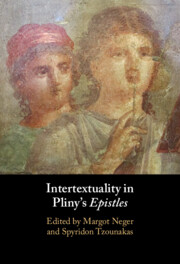Book contents
- Intertextuality in Pliny’s Epistles
- Intertextuality in Pliny’s Epistles
- Copyright page
- Contents
- Contributors
- Acknowledgements
- Abbreviations
- Introduction
- Part I Intertextuality and Interdiscursivity in Pliny’s Letters
- Part II Models and Anti-Models: Pliny’s Interaction with Oratory and Natural History
- Part III Pliny and Seneca: Discourses of Grief and Posthumous Reputation
- Chapter 7 Pliny’s Seneca and the Intertextuality of Grief
- Chapter 8 Intertextuality and Posthumous Reputation in Pliny’s Letter on the Death of Silius Italicus (Plin. Ep. 3.7)
- Part IV Pliny’s Villas and Their Poetic Models
- Part V Pliny Turns Nasty: Satire and the Scoptic Tradition
- Part VI Final Thoughts: Discourses of Representation and Reproduction
- Bibliography
- General Subject Index
- Index Locorum
Chapter 8 - Intertextuality and Posthumous Reputation in Pliny’s Letter on the Death of Silius Italicus (Plin. Ep. 3.7)
from Part III - Pliny and Seneca: Discourses of Grief and Posthumous Reputation
Published online by Cambridge University Press: 07 September 2023
- Intertextuality in Pliny’s Epistles
- Intertextuality in Pliny’s Epistles
- Copyright page
- Contents
- Contributors
- Acknowledgements
- Abbreviations
- Introduction
- Part I Intertextuality and Interdiscursivity in Pliny’s Letters
- Part II Models and Anti-Models: Pliny’s Interaction with Oratory and Natural History
- Part III Pliny and Seneca: Discourses of Grief and Posthumous Reputation
- Chapter 7 Pliny’s Seneca and the Intertextuality of Grief
- Chapter 8 Intertextuality and Posthumous Reputation in Pliny’s Letter on the Death of Silius Italicus (Plin. Ep. 3.7)
- Part IV Pliny’s Villas and Their Poetic Models
- Part V Pliny Turns Nasty: Satire and the Scoptic Tradition
- Part VI Final Thoughts: Discourses of Representation and Reproduction
- Bibliography
- General Subject Index
- Index Locorum
Summary
In his obituary of Silius Italicus (Ep. 3.7), Pliny uses a series of apposite intertextual allusions drawn from a variety of sources (especially from Seneca’s Dialogi and Epistles, Cicero’s Epistulae ad Familiares and Hesiod) which help him denigrate Silius’ posthumous reputation. Pliny evokes several titles of Senecan works and thus virtually creates an epistolary library with a section containing Stoic best sellers. In this letter, Pliny absorbs Seneca’s Stoicism, prompts his readers to evaluate Silius’ character through the lens of Stoic discourses and to notice an inconsistency between Silius’ Stoic death and his un-Stoic way of life, while all the while associating the epic poet with Epicureanism. He has good reasons to undermine Silius’ reputation, since the latter was Pliny’s rival for the title of Cicero’s heir. However, at the same time Pliny differentiates himself from Seneca by rejecting some of his central ideas, as e.g. his idea that human life is not short. The negative insinuations against Silius are further accentuated by intratextual links with other letters addressed to Caninius Rufus.
Keywords
- Type
- Chapter
- Information
- Intertextuality in Pliny's Epistles , pp. 164 - 184Publisher: Cambridge University PressPrint publication year: 2023

